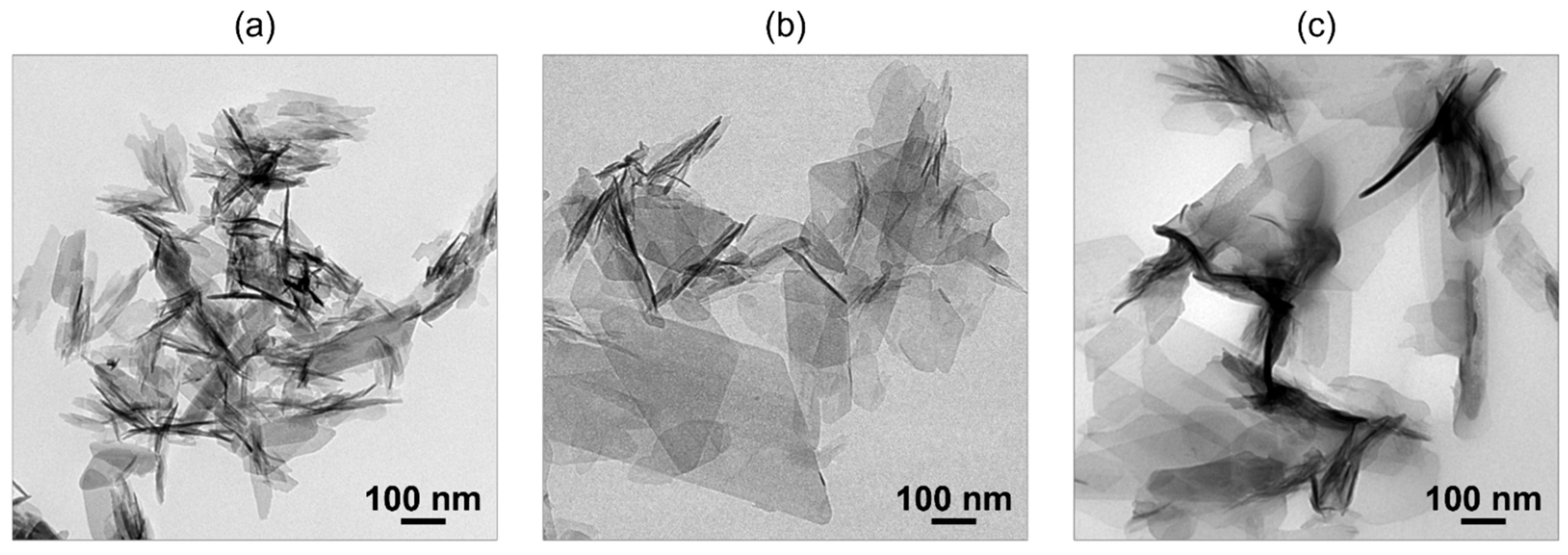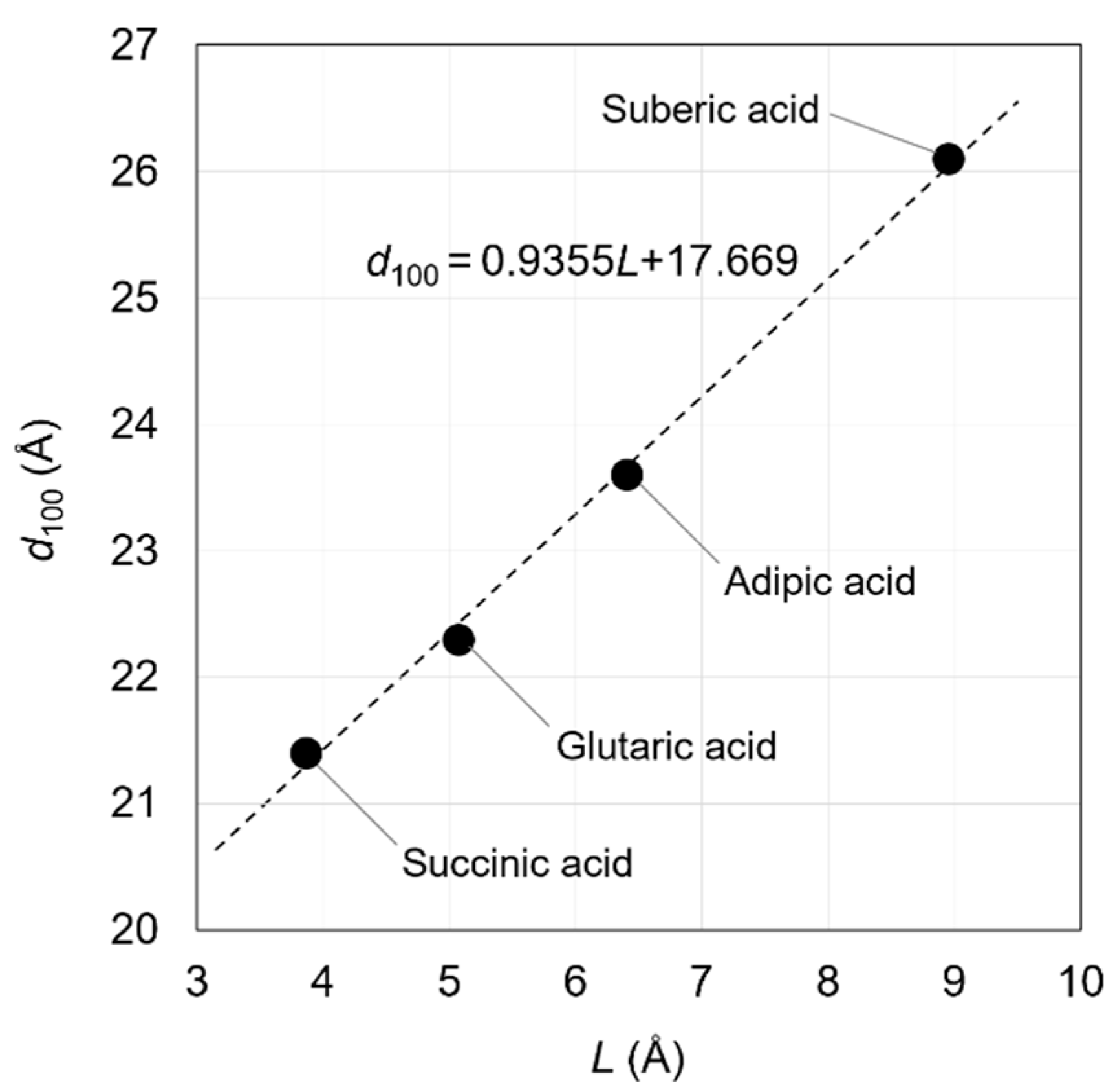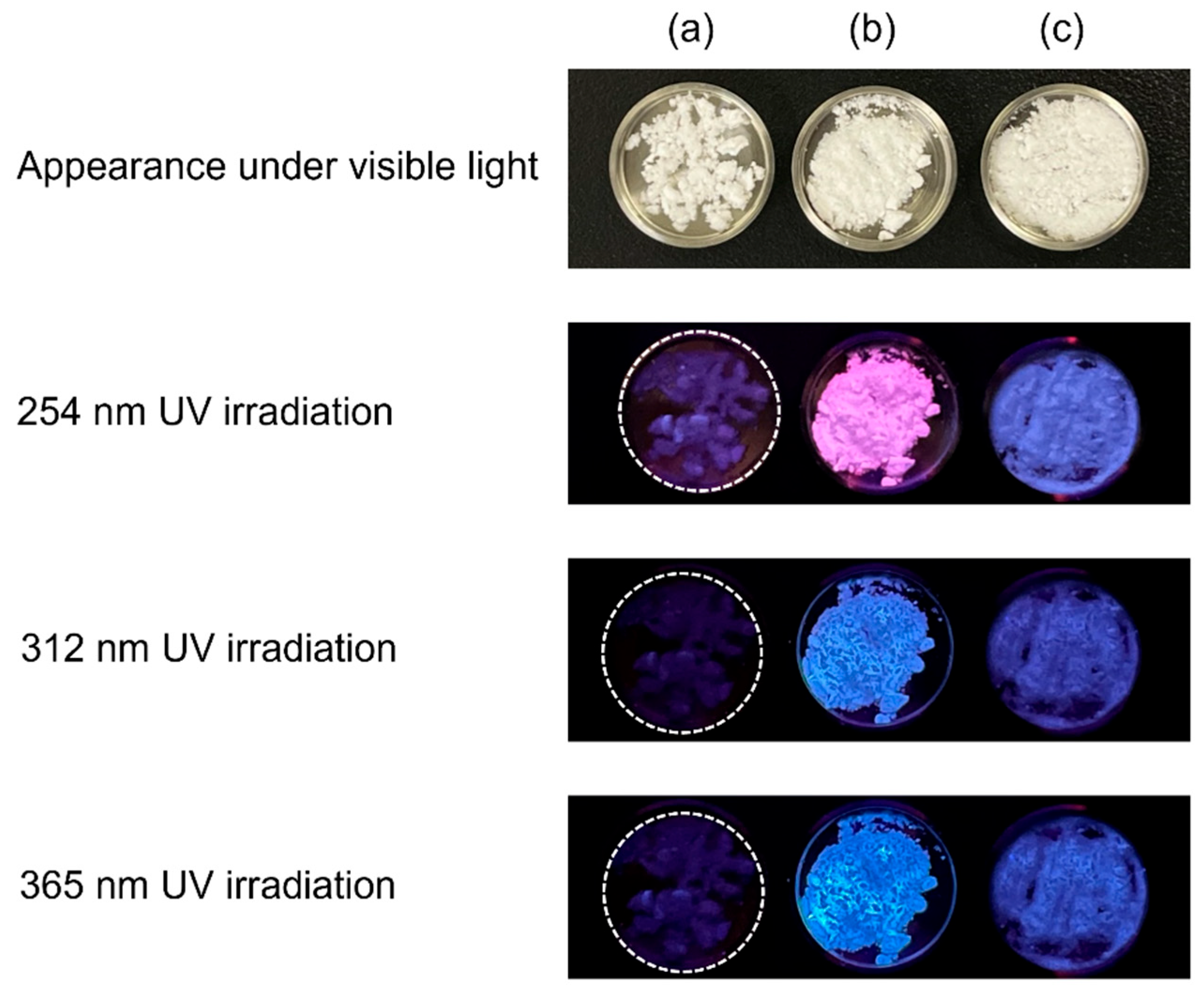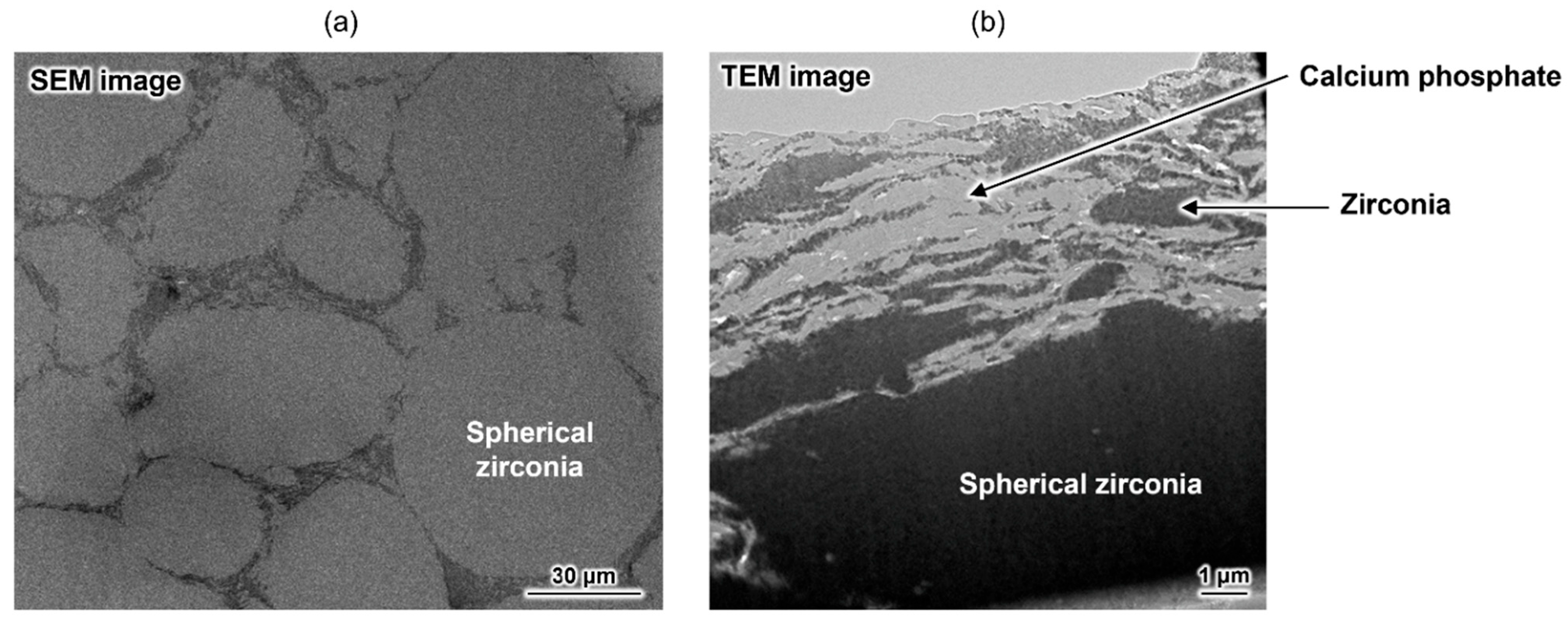Recent Advances in Octacalcium Phosphate with Incorporated Carboxylate Ions: A Review
Abstract
1. Introduction
2. Incorporation of Carboxylate Ions into OCP Interlayers
2.1. Synthesis of OCPCs
2.1.1. Hydrolysis of Calcium Phosphates
2.1.2. Synthesis Using Calcium Carbonate and Phosphoric Acid
2.1.3. Homogeneous Precipitation and Co-Precipitation Methods
2.2. Carboxylate Ions That Can Be Incorporated into OCP Interlayers
2.3. Steric Structure Estimation of Carboxylate Ions in OCP Interlayers
3. Development of Functional Materials Using OCPCs
3.1. Fluorescent Materials
3.2. Artificial Bones
3.2.1. OCP- and OCPC-Based Cement-Type Artificial Bones
3.2.2. Composite-Type Artificial Bones
3.3. Adsorbents
4. Future Challenges in OCPC Research
5. Conclusions
Author Contributions
Funding
Institutional Review Board Statement
Informed Consent Statement
Data Availability Statement
Conflicts of Interest
Abbreviations
| HAp | Hydroxyapatite |
| TCP | Tricalcium phosphate |
| OCP | Octacalcium phosphate |
| DCPD | Dicalcium phosphate dihydrate |
| IR | Infrared |
| NMR | Nuclear magnetic resonance |
| OCPC | Octacalcium phosphate carboxylate |
| XRD | X-ray diffraction |
| TEM | Transmission electron microscope |
| UV | Ultraviolet |
| SBF | Simulated body fluid |
| SEM | Scanning electron microscope |
References
- Sugai, Y.; Hamai, R.; Shiwaku, Y.; Anada, T.; Tsuchiya, K.; Kimura, T.; Tadano, M.; Yamauchi, K.; Takahashi, T.; Egusa, H.; et al. Effect of octacalcium phosphate on osteogenic differentiation of induced pluripotent stem cells in a 3D hybrid spheroid culture. Biomimetics 2025, 10, 205. [Google Scholar] [CrossRef]
- Hamai, R.; Tomitsuka, K.; Okada, M.; Tsuchiya, K.; Kimura, T.; Sakai, S.; Yamauchi, K.; Suzuki, O. Osteoclast formation in the co-presence of octacalcium phosphate and inorganic phosphorus-containing gelatin in vitro. Dent. Mater. J. 2025, 44, 414–426. [Google Scholar] [CrossRef] [PubMed]
- Xiao, L.; Shiwaku, Y.; Hamai, R.; Baba, K.; Tsuchiya, K.; Imazato, S.; Sasaki, K.; Suzuki, O. Osteogenic capacity of octacalcium phosphate involving macrophage polarization. J. Biomed. Mater. Res. Part A 2023, 111, 1006–1020. [Google Scholar] [CrossRef]
- Okuyama, K.; Shiwaku, Y.; Hamai, R.; Mizoguchi, T.; Tsuchiya, K.; Takahashi, T.; Suzuki, O. Differentiation of committed osteoblast progenitors by octacalcium phosphate compared to calcium-deficient hydroxyapatite in Lepr-cre/Tomato mouse tibia. Acta Biomater. 2022, 142, 332–344. [Google Scholar] [CrossRef]
- Koyama, S.; Hamai, R.; Shiwaku, Y.; Kurobane, T.; Tsuchiya, K.; Takahashi, T.; Suzuki, O. Angio-osteogenic capacity of octacalcium phosphate co-precipitated with copper gluconate in rat calvaria critical-sized defect. Sci. Technol. Adv. Mater. 2022, 23, 120–139. [Google Scholar] [CrossRef]
- Hamai, R.; Sakai, S.; Shiwaku, Y.; Anada, T.; Tsuchiya, K.; Ishimoto, T.; Nakano, T.; Suzuki, O. Octacalcium phosphate crystals including a higher density dislocation improve its materials osteogenecity. Appl. Mater. Today 2022, 26, 101279. [Google Scholar] [CrossRef]
- Kibe, T.; Maeda-Iino, A.; Takahashi, T.; Kamakura, S.; Suzuki, O.; Nakamura, N. A follow-up study on the clinical outcomes of alveolar reconstruction using octacalcium phosphate granules and atelocollagen complex. J. Oral Maxillofac. Surg. 2021, 79, 2462–2471. [Google Scholar] [CrossRef]
- Kawai, T.; Kamakura, S.; Matsui, K.; Fukuda, M.; Takano, H.; Iino, M.; Ishikawa, S.; Kawana, H.; Soma, T.; Imamura, E.; et al. Clinical study of octacalcium phosphate and collagen composite in oral and maxillofacial surgery. J. Tissue Eng. 2020, 11, 2041731419896449. [Google Scholar] [CrossRef] [PubMed]
- Kawai, T.; Suzuki, O.; Matsui, K.; Tanuma, Y.; Takahashi, T.; Kamakura, S. Octacalcium phosphate collagen composite facilitates bone regeneration of large mandibular bone defect in humans. J. Tissue Eng. Regen. Med. 2017, 11, 1641–1647. [Google Scholar] [CrossRef]
- Kawai, T.; Echigo, S.; Matsui, K.; Tanuma, Y.; Takahashi, T.; Suzuki, O.; Kamakura, S. First clinical application of octacalcium phosphate collagen composite in human bone defect. Tissue Eng. Part A 2014, 20, 1336–1341. [Google Scholar] [CrossRef] [PubMed]
- Tan, J.L.T.; Shimabukuro, M.; Tsuchiya, A.; Wijekoon, W.M.R.L.K.; Kishida, R.; Kawashita, M.; Ishikawa, K. Influence of porogens on architecture and osteogenesis of porous carbonate apatite artificial bones. Ceram. Int. 2025, 51, 19963–19972. [Google Scholar] [CrossRef]
- Takeda, S.; Tsuchiya, A.; Moriyama, M.; Ishikawa, K. Optimization of the structure of three-dimensional interconnected porous carbonate apatite bone grafts with spherical granules. Dent. Mater. J. 2025, 44, 233–240. [Google Scholar] [CrossRef]
- Shibahara, K.; Hayashi, K.; Nakashima, Y.; Ishikawa, K. Controlling the pore size of carbonate apatite honeycomb scaffolds enhances orientation and strength of regenerated bone. Biomater. Adv. 2025, 166, 214026. [Google Scholar] [CrossRef]
- Hayashi, K.; Teramoto, E.; Taleb Alashkar, A.N.; Lou, Z.; Moriyama, M.; Ishikawa, K. Antibacterial and angiogenic copper phosphate-modified carbonate apatite honeycomb plugs for enhanced gingival and alveolar bone regeneration. ACS Appl. Mater. Interfaces 2025, 17, 33340–33356. [Google Scholar] [CrossRef]
- Freitas, P.; Tan, J.L.T.; Ishikawa, K. Monolithic copper-doped carbonated apatite synthesized at low-temperature exhibits in vitro antibacterial effect and in vivo bone regenerative properties. Materialia 2025, 42, 102441. [Google Scholar] [CrossRef]
- Takeda, S.; Tsuchiya, A.; Moriyama, M.; Ishikawa, K. Physical and histological comparison of three-dimensional interconnected porous carbonate apatite bone graft fabricated with cylindrical and spherical granules. Ceram. Int. 2024, 50, 53544–53551. [Google Scholar] [CrossRef]
- Hayashi, K.; Zhang, C.; Taleb Alashkar, A.N.; Ishikawa, K. Carbonate apatite honeycomb scaffold-based drug delivery system for repairing osteoporotic bone defects. ACS Appl. Mater. Interfaces 2024, 16, 45956–45968. [Google Scholar] [CrossRef]
- Hayashi, K.; Kishida, R.; Tsuchiya, A.; Ishikawa, K. Transformable carbonate apatite chains as a novel type of bone graft. Adv. Healthc. Mater. 2024, 13, 2303245. [Google Scholar] [CrossRef]
- Umemoto, S.; Furusawa, T.; Unuma, H.; Goto, T.; Sekino, T. Evaluation of resorption rate-controlled calcium carbonate ceramics as a substitute bone material. Dent. Mater. J. 2025, 44, 9–16. [Google Scholar] [CrossRef]
- Umemoto, S.; Furusawa, T.; Unuma, H.; Tajika, M.; Sekino, T. In vivo bioresorbability and bone formation ability of sintered highly pure calcium carbonate granules. Dent. Mater. J. 2021, 40, 1202–1207. [Google Scholar] [CrossRef]
- Li, X.; Yang, X.; Liu, X.; He, W.; Huang, Q.; Li, S.; Feng, Q. Calcium carbonate nanoparticles promote osteogenesis compared to adipogenesis in human bone-marrow mesenchymal stem cells. Prog. Nat. Sci. Mater. Int. 2018, 28, 598–608. [Google Scholar] [CrossRef]
- Woldetsadik, A.D.; Sharma, S.K.; Khapli, S.; Jagannathan, R.; Magzoub, M. Hierarchically porous calcium carbonate scaffolds for bone tissue engineering. ACS Biomater. Sci. Eng. 2017, 3, 2457–2469. [Google Scholar] [CrossRef]
- Neumeyer, D.; Venturini, C.; Ratel-Ramond, N.; Verelst, M.; Gourdon, A. Simple and economic elaboration of high purity CaCO3 particles for bone graft applications using a spray pyrolysis technique. J. Mater. Chem. B 2017, 5, 6897–6907. [Google Scholar] [CrossRef]
- Tolba, E.; Müller, W.E.G.; El-Hady, B.M.A.; Neufurth, M.; Wurm, F.; Wang, S.; Schröder, H.C.; Wang, X. High biocompatibility and improved osteogenic potential of amorphous calcium carbonate/vaterite. J. Mater. Chem. B 2016, 4, 376–386. [Google Scholar] [CrossRef]
- Mathew, M.; Brown, W.E.; Schroeder, L.W.; Dickens, B. Crystal structure of octacalcium bis(hydrogenphosphate) tetrakis(phosphate) pentahydrate, Ca8(HPO4)2(PO4)4∙5H2O. J. Crystallogr. Spectrosc. Res. 1988, 18, 235–250. [Google Scholar] [CrossRef]
- Brown, W.E.; Smith, J.P.; Lehr, J.R.; Frazier, A.W. Octacalcium phosphate and hydroxyapatite: Crystallographic and chemical relations between octacalcium phosphate and hydroxyapatite. Nature 1962, 196, 1050–1055. [Google Scholar] [CrossRef]
- Brown, W.E.; Lehr, J.R.; Smith, J.P.; Frazier, A.W. Crystallography of octacalcium phosphate. J. Am. Chem. Soc. 1957, 79, 5318–5319. [Google Scholar] [CrossRef]
- Monma, H.; Goto, M. Succinate-complexed octacalcium phosphate. Bull. Chem. Soc. Jpn. 1983, 56, 3843–3844. [Google Scholar] [CrossRef]
- Yokoi, T.; Shimabukuro, M.; Kawashita, M. Octacalcium phosphate with incorporated carboxylate ions: A review. Sci. Technol. Adv. Mater. 2022, 23, 434–445. [Google Scholar] [CrossRef]
- Mathew, M.; Brown, W.E. A structural model for octacalcium phosphate-succinate double salt. Bull. Chem. Soc. Jpn. 1987, 60, 1141–1143. [Google Scholar] [CrossRef]
- Fowler, B.O.; Marković, M.; Brown, W.E. Octacalcium phosphate. 3. Infrared and Raman vibrational spectra. Chem. Mater. 1993, 5, 1417–1423. [Google Scholar] [CrossRef]
- Marković, M.; Fowler, B.O.; Brown, W.E. Octacalcium phosphate carboxylates. 2. Characterization and structural considerations. Chem. Mater. 1993, 5, 1406–1416. [Google Scholar] [CrossRef]
- Li, Y.; Reid, D.G.; Duer, M.J.; Chan, J.C.C. Solid state NMR–An indispensable tool in organic-inorganic biocomposite characterization; refining the structure of octacalcium phosphate composites with the linear metabolic di-acids succinate and adipate. Solid State Nucl. Magn. Reson. 2018, 95, 1–5. [Google Scholar] [CrossRef]
- Tsai, T.W.T.; Chou, F.-C.; Tseng, Y.-H.; Chan, J.C.C. Solid-state P-31 NMR study of octacalcium phosphate incorporated with succinate. Phys. Chem. Chem. Phys. 2010, 12, 6692–6697. [Google Scholar] [CrossRef]
- Laurencin, D.; Li, Y.; Duer, M.J.; Iuga, D.; Gervais, C.; Bonhomme, C. A 43Ca nuclear magnetic resonance perspective on octacalcium phosphate and its hybrid derivatives. Magn. Reson. Chem. 2021, 59, 1048–1061. [Google Scholar] [CrossRef]
- Nakahira, A.; Aoki, S.; Sakamoto, K.; Yamaguchi, S. Synthesis and evaluation of various layered octacalcium phosphates by wet-chemical processing. J. Mater. Sci. Mater. Med. 2001, 12, 793–800. [Google Scholar] [CrossRef]
- Aoki, S.; Sakamoto, K.; Yamaguchi, S.; Nakahira, A. Syntheses of octacalcium phosphate containing dicarboxylic acids and effects of the side groups on the crystal growth of octacalcium phosphate. J. Ceram. Soc. Jpn. 2000, 108, 909–914. [Google Scholar] [CrossRef]
- Marković, M.; Fowler, B.O.; Brown, W.E. Octacalcium phosphate carboxylates. 1. Preparation and identification. Chem. Mater. 1993, 5, 1401–1405. [Google Scholar] [CrossRef]
- Monma, H.; Nishikawa, H. Thermal behavior of octacalcium phosphate intercalated with β-dihydromuconate. J. Ceram. Soc. Jpn. 1992, 100, 373–376. [Google Scholar] [CrossRef]
- Monma, H. The incorporation of dicarboxylates into octacalcium bis(hydrogenphosphate) tetrakis(phosphate) pentahydrate. Bull. Chem. Soc. Jpn. 1984, 57, 599–600. [Google Scholar] [CrossRef]
- Yokoi, T.; Goto, T.; Kitaoka, S. Transformation of dicalcium phosphate dihydrate into octacalcium phosphate with incorporated dicarboxylate ions. J. Ceram. Soc. Jpn. 2018, 126, 462–468. [Google Scholar] [CrossRef]
- Kamitakahara, M.; Okano, H.; Tanihara, M.; Ohtsuki, C. Synthesis of octacalcium phosphate intercalated with dicarboxylate ions from calcium carbonate and phosphoric acid. J. Ceram. Soc. Jpn. 2008, 116, 481–485. [Google Scholar] [CrossRef]
- Yokoi, T.; Watanabe, M.; Goto, T.; Meng, S.; Sekino, T.; Shimabukuro, M.; Kawashita, M. Synthesis of octacalcium phosphate containing glutarate ions with a high incorporation fraction. Materials 2022, 16, 64. [Google Scholar] [CrossRef]
- Monma, H. Apatitic intercalation compounds containing dicarboxylates. Gypsum Lime 1992, 237, 108–114. [Google Scholar] [CrossRef]
- Kijima, T.; Yamaguchi, K.; Miyata, A.; Yada, M.; Machida, M.; Tanaka, J. Crystallization of calcium phosphate templated by α-amino acids depending on their composition, chain length, and enantiomerism. Chem. Lett. 2000, 29, 1324–1325. [Google Scholar] [CrossRef]
- Yokoi, T.; Goto, T.; Sekino, T.; Hasegawa, T.; Chen, P.; Kanetaka, H.; Yoshida, K.; Shimabukuro, M.; Kawashita, M. LaMer-model-based synthesis method for fine particles of octacalcium phosphate and related functional compounds. CrystEngComm 2024, 26, 6008–6016. [Google Scholar] [CrossRef]
- Sugiura, Y.; Yamada, E.; Horie, M. Interlayer expansion of octacalcium phosphate via forced oxidation of the intercalated molecules within its interlayers. Phys. Chem. Chem. Phys. 2023, 25, 26640–26647. [Google Scholar] [CrossRef]
- Yokoi, T.; Watanabe, M.; Nakamura, F.; Kimura-Suda, H.; Shimabukuro, M.; Kawashita, M. Formation of octacalcium phosphate with incorporated dicarboxylate ions containing disulfide bonds. Dalton Trans. 2023, 52, 16586–16590. [Google Scholar] [CrossRef]
- Yokoi, T.; Watanabe, M.; Kawashita, M. Octacalcium phosphate with incorporated terephthalate ion derivatives: Novel guest molecules and unique fluorescence properties. Dalton Trans. 2024, 53, 14163–14170. [Google Scholar] [CrossRef]
- Kataoka, T.; Nishiyama, S.; Fujii, E.; Yoshioka, T.; Hayakawa, S. Synthesis and structural characterization of Sr(II) ion-containing octacalcium phosphate incorporated with both 2,6-pyridinedicarboxylate and succinate ions as a bone defect filler with multiple drug loading capability. Colloids Surf. A Physicochem. Eng. Aspects 2024, 693, 134001. [Google Scholar] [CrossRef]
- Yokoi, T.; Watanabe, M.; Wang, Y.; Goto, T.; Sekino, T.; Shimabukuro, M.; Kawashita, M. Synthesis and fluorescence properties of octacalcium phosphate with incorporated pyridinedicarboxylate ions. J. Ceram. Soc. Jpn. 2023, 131, 701–707. [Google Scholar] [CrossRef]
- Yokoi, T.; Watanabe, M.; Kawashita, M. Octacalcium phosphate with incorporated meso-2,3-dimercaptosuccinate ions exhibiting continuous interplanar spacing expansion. J. Ceram. Soc. Jpn. 2024, 132, 609–612. [Google Scholar] [CrossRef]
- Yokoi, T.; Kawashita, M. Understanding the steric structures of dicarboxylate ions incorporated in octacalcium phosphate crystals. Materials 2021, 14, 2703. [Google Scholar] [CrossRef]
- Maeda, K.; Motohashi, T.; Ohtani, R.; Sugimoto, K.; Tsuji, Y.; Kuwabara, A.; Horike, S. Supra-ceramics: A molecule-driven frontier of inorganic materials. Sci. Technol. Adv. Mater. 2024, 25, 2416384. [Google Scholar] [CrossRef]
- Yamada, I.; Tagaya, M. Immobilization of 2,2′-bipyridine-5,5′-dicarboxylic acid in layered octacalcium phosphate. Colloids Interface Sci. Commun. 2019, 30, 100182. [Google Scholar] [CrossRef]
- Yokoi, T.; Goto, T.; Hara, M.; Sekino, T.; Seki, T.; Kamitakahara, M.; Ohtsuki, C.; Kitaoka, S.; Takahashi, S.; Kawashita, M. Incorporation of tetracarboxylate ions into octacalcium phosphate for the development of next-generation biofriendly materials. Commun. Chem. 2021, 4, 4. [Google Scholar] [CrossRef]
- Yokoi, T.; Goto, T.; Sekino, T.; Kawashita, M. Fluorescent properties of octacalcium phosphate with incorporated isophthalate ions. J. Ceram. Soc. Jpn. 2022, 130, 337–340. [Google Scholar] [CrossRef]
- Bandaru, S.; Palanivel, M.; Ravipati, M.; Wu, W.-Y.; Zahid, S.; Halkarni, S.S.; Dalapati, G.K.; Ghosh, K.K.; Gulyás, B.; Padmanabhan, P.; et al. Highly monodisperse, size tunable glucosamine conjugated CdSe quantum dots for enhanced cellular uptake and bioimaging. ACS Omega 2024, 9, 7452–7462. [Google Scholar] [CrossRef] [PubMed]
- Zhang, H.; Sun, C.; Sun, L.; Xu, W.; Wu, W.; Chen, J.; Wang, B.; Yu, J.; Cui, P.; Zhang, F.; et al. Stable monodisperse Pb1−xCdxS quantum dots for NIR-II bioimaging by aqueous coprecipitation of bimetallic clusters. Angew. Chem. Int. Ed. 2022, 61, e202203851. [Google Scholar] [CrossRef]
- Venkatachalam, N.; Yamano, T.; Hemmer, E.; Hyodo, H.; Kishimoto, H.; Soga, K. Er3+-doped Y2O3 nanophosphors for near-infrared fluorescence bioimaging applications. J. Am. Ceram. Soc. 2013, 96, 2759–2765. [Google Scholar] [CrossRef]
- Hemmer, E.; Yamano, T.; Kishimoto, H.; Venkatachalam, N.; Hyodo, H.; Soga, K. Cytotoxic aspects of gadolinium oxide nanostructures for up-conversion and NIR bioimaging. Acta Biomater. 2013, 9, 4734–4743. [Google Scholar] [CrossRef]
- Insley, G.; Suzuki, O. Octacalcium Phosphate Biomaterials: Understanding of Bioactive Properties and Application; Woodhead Publishing: Sawston, UK, 2019; ISBN 978-0-08-102512-3. [Google Scholar]
- Ishihara, S.; Matsumoto, T.; Onoki, T.; Sohmura, T.; Nakahira, A. New concept bioceramics composed of octacalcium phosphate (OCP) and dicarboxylic acid-intercalated OCP via hydrothermal hot-pressing. Mater. Sci. Eng. C 2009, 29, 1885–1888. [Google Scholar] [CrossRef]
- Sugiura, Y.; Saito, Y.; Yamada, E.; Horie, M. Fabrication of dicarboxylic-acid- and silica-substituted octacalcium phosphate blocks with stronger mechanical strength. Ceramics 2024, 7, 796–806. [Google Scholar] [CrossRef]
- Sugiura, Y.; Yamada, E.; Horie, M. Fabrication of dicarboxylic-acid-substituted octacalcium phosphate blocks via cementing. Ceram. Int. 2023, 49, 9719–9724. [Google Scholar] [CrossRef]
- Bermúdez, O.; Boltong, M.G.; Driessens, F.C.M.; Planell, J.A. Development of some calcium phosphate cements from combinations of α-TCP, MCPM and CaO. J. Mater. Sci. Mater. Med. 1994, 5, 160–163. [Google Scholar] [CrossRef]
- Mirtchi, A.A.; Lemaitre, J.; Terao, N. Calcium-phosphate cements: Study of the beta-tricalcium phosphate–monocalcium phosphate system. Biomaterials 1989, 10, 475–480. [Google Scholar] [CrossRef] [PubMed]
- Matsumine, A.; Kusuzaki, K.; Matsubara, T.; Okamura, A.; Okuyama, N.; Miyazaki, S.; Shintani, K.; Uchida, A. Calcium phosphate cement in musculoskeletal tumor surgery. J. Surg. Oncol. 2006, 93, 212–220. [Google Scholar] [CrossRef] [PubMed]
- Kuroyama, K.; Fujikawa, R.; Goto, T.; Sekino, T.; Nakamura, F.; Kimura-Suda, H.; Chen, P.; Kanetaka, H.; Hasegawa, T.; Yoshida, K.; et al. Development of bioinspired damage-tolerant calcium phosphate bulk materials. Sci. Technol. Adv. Mater. 2023, 24, 2261836. [Google Scholar] [CrossRef]
- Kakisawa, H.; Sumitomo, T. The toughening mechanism of nacre and structural materials inspired by nacre. Sci. Technol. Adv. Mater. 2011, 12, 064710. [Google Scholar] [CrossRef]
- Barthelat, F.; Espinosa, H.D. An experimental investigation of deformation and fracture of nacre–mother of pearl. Exp. Mech. 2007, 47, 311–324. [Google Scholar] [CrossRef]
- Wang, Y.; Liu, Q.; Zhang, B.; Zhang, H.; Zhong, Z.; Ye, J.; Ren, Y.; Shen, L.; Ye, F.; Wang, W. Bioinspired nacre-like 2024Al/B4C composites with high damage tolerance. Ceram. Int. 2022, 48, 26326–26334. [Google Scholar] [CrossRef]
- Wan, H.; Leung, N.; Jargalsaikhan, U.; Ho, E.; Wang, C.; Liu, Q.; Peng, H.-X.; Su, B.; Sui, T. Fabrication and characterisation of alumina/aluminium composite materials with a nacre-like micro-layered architecture. Mater. Des. 2022, 223, 111190. [Google Scholar] [CrossRef]
- Li, Y.-L.; Guo, R.-F.; Hu, Z.-J.; Shen, P. Construction of nacre-mimetic composites with a “brick-and-mortar” architecture based on structural defects in ice-templating. Mater. Des. 2021, 204, 109668. [Google Scholar] [CrossRef]
- Yokoi, T.; Chen, P.; Yoshida, K.; Seo, Y.; Goto, T.; Kuroyama, K.; Sekino, T.; Hasegawa, T.; Yoda, T.; Kanetaka, H.; et al. Development of zirconia/calcium phosphate/pyrolytic carbon composites with nanoscale lamellar-structured grain boundary phases to control crack propagation for biomedical applications. ACS Appl. Nano Mater. 2025, 8, 7039–7048. [Google Scholar] [CrossRef]
- Aoki, S.; Nakahira, A.; Nakayama, H.; Sakamoto, K.; Yamaguchi, S.; Suganuma, K. Synthesis and aldehyde absorption properties of aspartate-octacalcium phosphate inclusion compound. J. Phys. Chem. Solids 2004, 65, 465–470. [Google Scholar] [CrossRef]
- Kataoka, T.; Koga, A.; Nishiyama, S.; Yoshioka, T.; Hayakawa, S. Improvement of caffeine adsorption on octacalcium phosphate through suberate ion incorporation. Mater. Lett. 2025, 385, 138188. [Google Scholar] [CrossRef]





| Carboxylic Acid (CAS No.) | Formula | Mw * | OCPC Formation | Year |
|---|---|---|---|---|
| Dithiodiglycolic acid (505-73-7) | HOOCCH2SSCH2COOH | 182.21 | Yes | 2023 |
| 3,3′-Dithiodipropionic acid (1119-62-6) | HOOC(CH2)2SS(CH2)2COOH | 210.26 | Yes | 2023 |
| 2,5-Pyridinedicarboxylic acid (100-26-5) | HOOC(C5H3N)COOH | 167.12 | Yes | 2023 |
| 2,6-Pyridinedicarboxylic acid (499-83-2) | HOOC(C5H3N)COOH | 167.12 | Yes | 2024 |
| 4-(Carboxymethyl)benzoic acid (501-89-3) | HOOC(C6H4)CH2COOH | 180.16 | Yes | 2024 |
| 1,4-Phenylenediacetic acid (7325-46-4) | HOOCCH2(C6H4)CH2COOH | 194.19 | Yes | 2024 |
| meso-2,3-dimercaptosuccinic acid (304-55-2) | HOOCCH(SH)CH(SH)COOH | 182.21 | Yes | 2024 |
Disclaimer/Publisher’s Note: The statements, opinions and data contained in all publications are solely those of the individual author(s) and contributor(s) and not of MDPI and/or the editor(s). MDPI and/or the editor(s) disclaim responsibility for any injury to people or property resulting from any ideas, methods, instructions or products referred to in the content. |
© 2025 by the authors. Licensee MDPI, Basel, Switzerland. This article is an open access article distributed under the terms and conditions of the Creative Commons Attribution (CC BY) license (https://creativecommons.org/licenses/by/4.0/).
Share and Cite
Yokoi, T.; Chen, P.; Watanabe, M.; Kawashita, M. Recent Advances in Octacalcium Phosphate with Incorporated Carboxylate Ions: A Review. Molecules 2025, 30, 3508. https://doi.org/10.3390/molecules30173508
Yokoi T, Chen P, Watanabe M, Kawashita M. Recent Advances in Octacalcium Phosphate with Incorporated Carboxylate Ions: A Review. Molecules. 2025; 30(17):3508. https://doi.org/10.3390/molecules30173508
Chicago/Turabian StyleYokoi, Taishi, Peng Chen, Masahiro Watanabe, and Masakazu Kawashita. 2025. "Recent Advances in Octacalcium Phosphate with Incorporated Carboxylate Ions: A Review" Molecules 30, no. 17: 3508. https://doi.org/10.3390/molecules30173508
APA StyleYokoi, T., Chen, P., Watanabe, M., & Kawashita, M. (2025). Recent Advances in Octacalcium Phosphate with Incorporated Carboxylate Ions: A Review. Molecules, 30(17), 3508. https://doi.org/10.3390/molecules30173508










